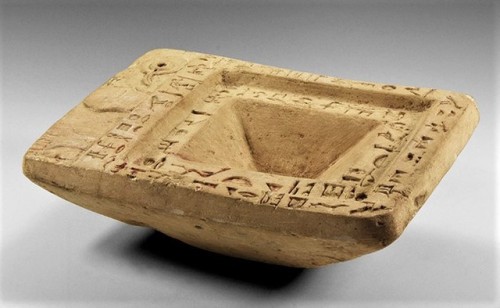Egyptian Offering Table with Hieroglyphic Inscription, Late New Kingdom, 1294-1077 BCA rectangular l
Egyptian Offering Table with Hieroglyphic Inscription, Late New Kingdom, 1294-1077 BCA rectangular limestone offering table with deeply recessed square section to the center for offerings, flat rim to the sides engraved with hieroglyphs; raised border to the edge engraved with hieroglyphs to the top; upper register decorated with three offering vessels; traces of red and black pigment to the hieroglyphs; chamfered edge with deeply sloping slides to a flat base. 5.01 kgOfferings of food were basic to the continued existence of the gods and the dead alike. They were often presented to them on special tables. In the homes these might stand in niches in a room used as a domestic shrine, in temples in rooms dedicated to offerings and in funerary chapels above the tomb, otherwise it was placed on the ground on top of the grave. The offering tables were decorated with food stuffs and inscribed with the offering prayers, which would nourish the deceased through their magic, if real foodstuffs were not provided. In depictions the offering tables are laden with a great variety of exquisite foodstuffs, and quite possibly that was the quality and quantity of offerings customary among the rich.The ancient Egyptians held feasts on a variety of occasions, most of which were connected to religious observances or commemorations of the dead. These banquets ideally featured large gatherings of family members and close associates, music and dance, and copious amounts of food. -- source link
#history#egyptian#offering table#hieroglyphs#new kingdom#limestone

